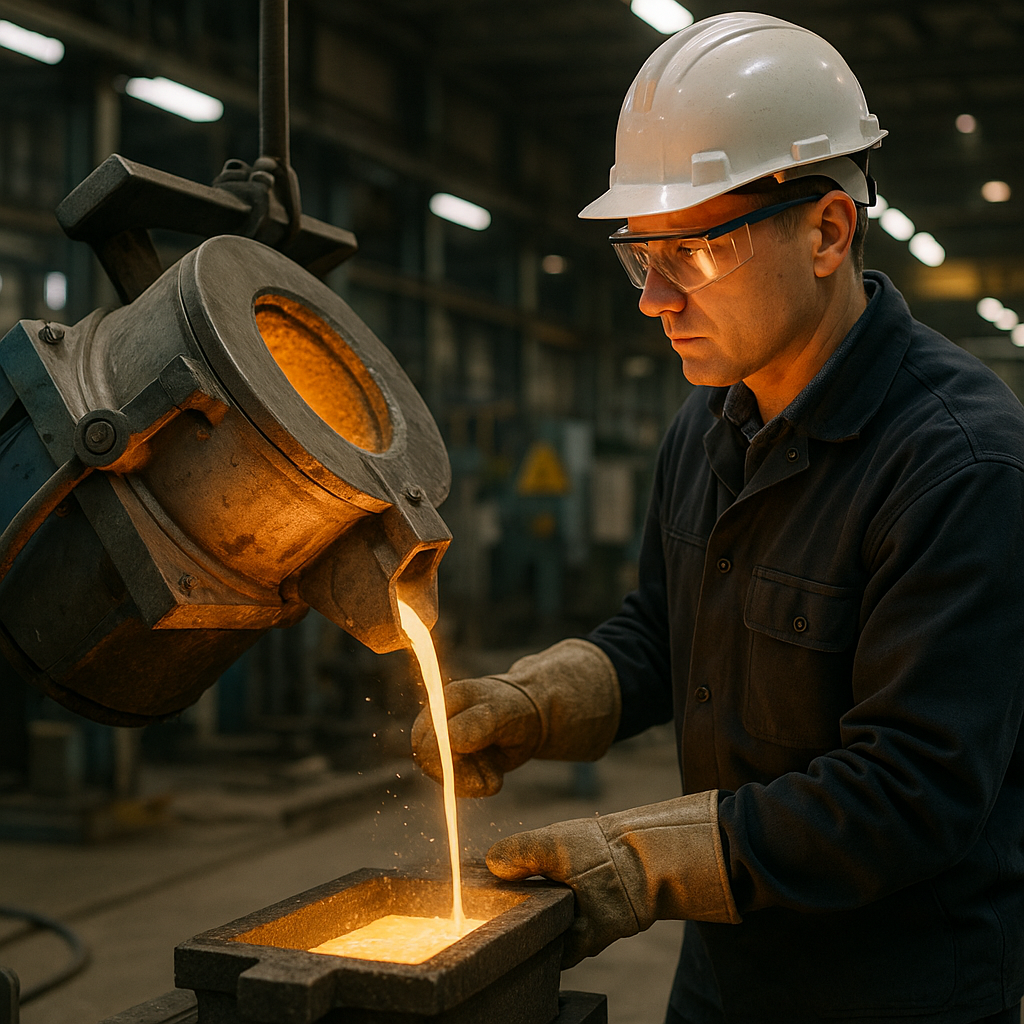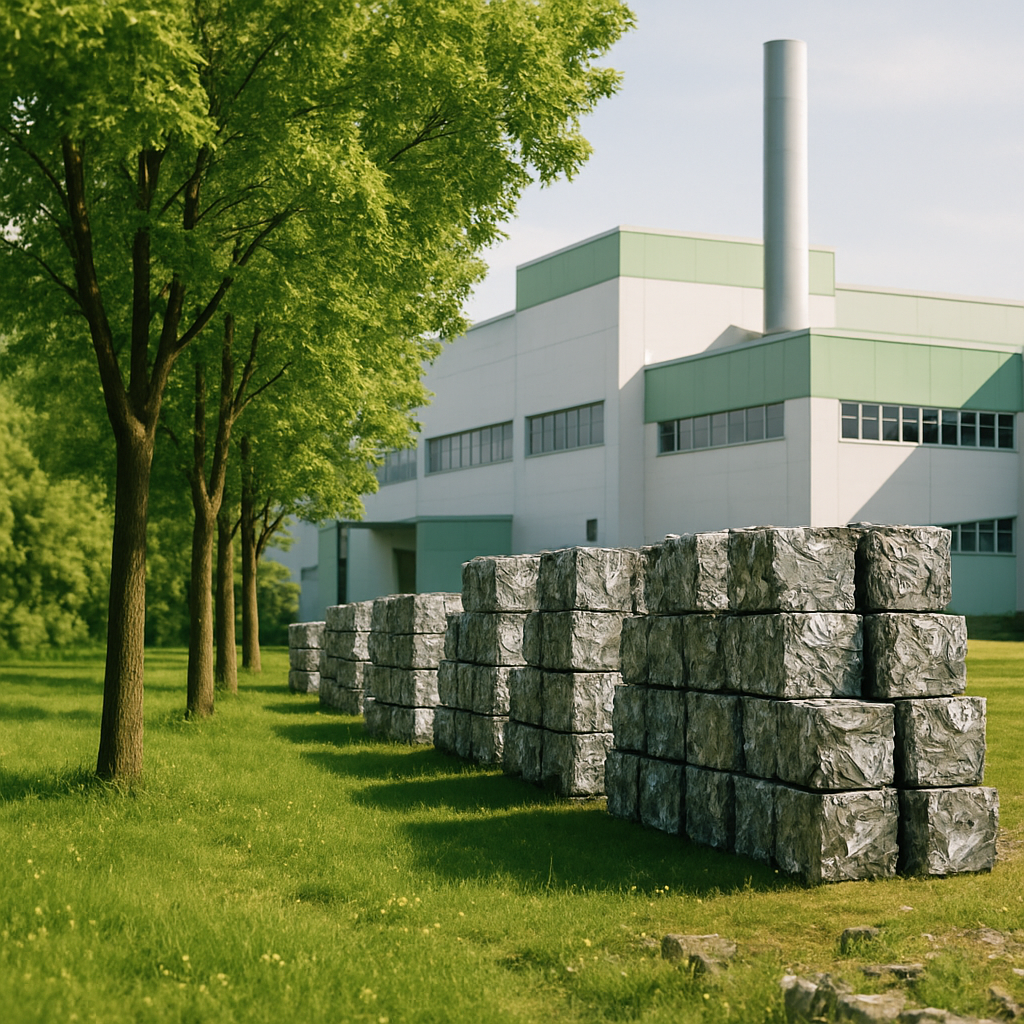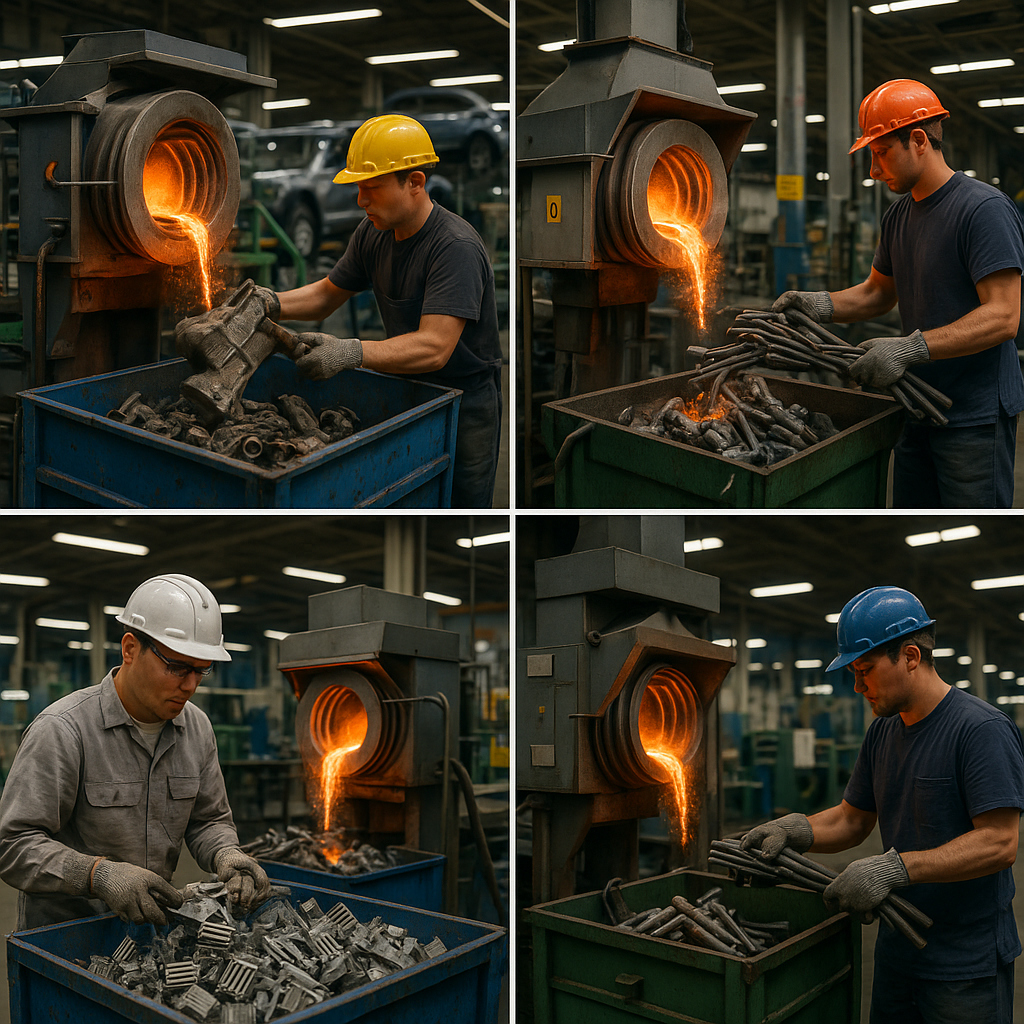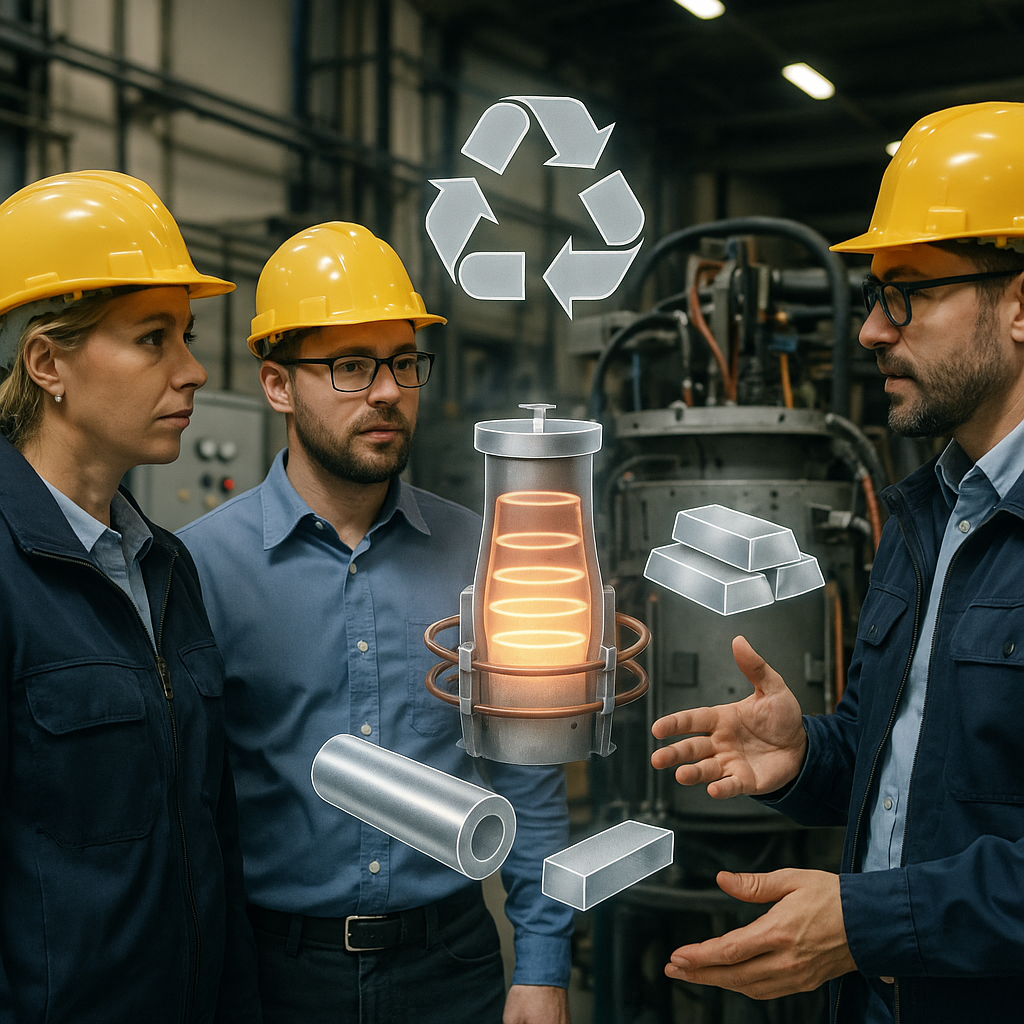5901 Botham Jean Blvd, Dallas, TX 75215
Induction Furnace Recycling: Process, Benefits, and Industrial Applications
September 30, 2025The global emphasis on sustainable resource management has made metal recycling more important than ever. At the center of modern metal recovery technology is induction furnace recycling—a sophisticated process that is transforming how we reclaim valuable materials from scrap.
Induction furnace recycling uses electromagnetic fields to generate precise, controlled heat to efficiently melt metal scrap. It works by passing electric current through copper coils surrounding a crucible, creating a fluctuating magnetic field that induces eddy currents within the conductive metal scrap. The resistance to these currents generates intense heat that rapidly melts the material without direct contact between the heating element and the metal.
This technology is well-suited for processing various metal scraps, including steel, aluminum, copper, and precious metals. Unlike traditional furnace methods that rely on fossil fuels, induction furnaces offer significant advantages: faster melting times with precise temperature control, reduced operational costs due to energy efficiency, and minimal emissions and waste, making them an environmentally responsible choice for metal recycling operations across industries.
How Does Induction Furnace Recycling Work?

Induction furnace recycling transforms scrap metal into reusable materials through a process based on electromagnetic induction. Unlike traditional methods that rely on direct flame, this technology uses electric currents to heat metal without contact, resulting in faster melting times and superior control.
The Science Behind Induction Heating
Fundamentally, induction furnace recycling operates through a clever application of physics. When electric current flows through a coil surrounding the furnace, it generates a rapidly changing magnetic field. This field induces eddy currents within the metal scrap.
These eddy currents flow in circular patterns through the conductive metal. As they encounter the material’s natural electrical resistance, they generate intense heat from within rather than from an external source. This principle makes induction heating both efficient and precise.
Key Stages of the Induction Recycling Process
The induction recycling process consists of three main stages:
- Scrap Pretreatment: Metal scrap is sorted, cleaned, and sized appropriately. Contaminants like oil, paint, and non-metallic materials are removed to prevent impurities in the final product.
- Melting Process: The prepared scrap is loaded into the furnace where the electromagnetic field rapidly heats it. A 3-ton furnace typically reaches temperatures of 1,500°C in just 12-15 minutes at 750-1000 kW power.
- Post-Processing: Once melted, the liquid metal undergoes refinement. Slag (impurities that float to the surface) is removed, and the composition may be adjusted by adding specific elements to achieve the desired properties.
Technical Advantages of Induction Melting
Induction furnace technology offers several advantages over conventional melting methods:
First, it provides exceptional temperature control with precision typically within ±10°C. This accuracy prevents overheating that could damage valuable alloying elements and ensures consistent quality.
The process also features natural electromagnetic stirring. Eddy currents create circulation within the molten metal, promoting uniform chemistry throughout the melt without requiring additional mechanical stirring.
For specialized applications, vacuum induction can be employed to remove gases like hydrogen and nitrogen to extremely low levels, which is critical for aerospace and nuclear applications.
Environmental and Economic Benefits
From a sustainability perspective, induction furnace recycling offers significant advantages. When processing clean scrap, induction furnaces produce just 0.8 kg CO₂ per ton—93% less than electric arc furnaces. The technology also eliminates SO₂ and NOx emissions since there are no combustion processes involved.
Energy efficiency is another key benefit. The direct heating of the metal, rather than the surrounding environment, reduces electricity consumption by 15-30% compared to other methods. This efficiency, combined with minimal metal loss through oxidation, makes induction furnace recycling both environmentally sound and economically viable.
| Parameter | Value/Description |
| Power Rating | 700-1000 kW |
| Operating Frequency | Range from 70 Hz to 10 kHz for various applications |
| Energy Efficiency | More than 90% for induction furnaces; 15-28% for gas-fired crucibles |
| Material Lifespan (Crucible) | Dependent on heating/cooling cycles, slag type |
| Emissions | 0.8 kg CO₂ per ton of clean scrap |
| Temperature Control Precision | ±10°C |
| Melting Temperature | Up to 1,500°C |
| Melting Time | Approx. 12-15 minutes for 3-ton charge |
Today, induction furnace technology is widely used for recycling various metals, from steel and iron to valuable non-ferrous metals like aluminum, copper, and precious metals. Its combination of speed, precision, and environmental performance makes it an essential technology in modern metal recycling operations.
What Are the Environmental Benefits of Induction Furnace Recycling?

Induction furnace recycling signifies a significant advancement in sustainable metal processing. This technology emits only 0.8 kg of CO2 per ton of processed clean scrap, achieving a remarkable 93% reduction in carbon emissions compared to traditional electric arc furnaces. The environmental impact is substantial, particularly when implemented on an industrial scale.
The elimination of harmful byproducts is another noteworthy advantage. Unlike conventional metal recycling methods, induction furnaces operate without producing sulfur dioxide (SO2) and nitrogen oxides (NOx), pollutants that contribute to acid rain and smog. Their elimination helps preserve air quality and reduces the environmental footprint of recycling operations.
Waste reduction is a key benefit of induction furnace technology. The process decreases waste generation by up to 40% compared to traditional methods. This improvement stems from more efficient melting that minimizes material loss and produces fewer byproducts requiring disposal. The precise temperature control enables optimal processing conditions that maximize material recovery.
Energy efficiency stands out as one of the most compelling advantages of induction furnace recycling. The technology directs energy directly into the metal rather than heating the surrounding air, minimizing energy waste and reducing overall consumption. Many facilities report energy savings of 30-80% when transitioning from conventional methods to induction technology.
Compatibility with renewable energy sources further enhances the environmental profile of induction furnace recycling. These systems can be powered by solar, wind, or hydroelectric energy, allowing recycling operations to reduce their reliance on fossil fuels and move toward carbon-neutral processing. As the renewable energy sector expands, this advantage grows increasingly significant.
The circular economy benefits greatly from induction furnace technology. The process efficiently recycles scrap metal, reducing demand for virgin materials from mining operations. This closed-loop approach conserves natural resources and minimizes environmental damage from extraction activities. The high-quality outputs maintain material integrity through multiple recycling cycles.
Operational safety improvements also contribute to environmental protection. Induction furnaces eliminate the need to handle hazardous fuels and reduce the risk of spills or leaks that could contaminate soil or water sources. The compact design of these systems requires less space, potentially decreasing the physical footprint of recycling facilities.
Water conservation is another environmental benefit. Traditional metal processing often demands substantial water for cooling and other processes. Induction furnaces utilize closed-loop cooling systems, significantly reducing water consumption and minimizing wastewater generation—a particularly valuable advantage in regions facing water scarcity challenges.
What Are the Economic Advantages of Induction Furnace Recycling?
Induction furnace recycling offers significant economic benefits that directly enhance a recycler’s profitability. This technology shifts metal recycling from a resource-heavy process to a streamlined operation with notable cost savings and improved efficiency.
Lower Energy Consumption
Energy costs are among the largest operational expenses in metal recycling. Induction furnaces decrease electricity consumption by 15-30% compared to traditional melting methods. This reduction occurs because the furnace generates heat directly within the metal rather than transferring it from an external source.
A medium-sized foundry processing 500 tons of aluminum monthly can save approximately $8,000-$12,000 on energy costs alone. These savings accumulate quickly, making the technology particularly appealing as energy prices rise in many regions.
The efficiency advantage becomes even more noticeable when processing certain metals. In aluminum recycling, induction furnaces use just 5% of the energy required for primary production from bauxite ore, creating a substantial cost differential that enhances profit margins.
Improved Metal Recovery Rates
Traditional metal recycling processes often result in considerable material loss through oxidation and slag formation. Induction furnace technology reduces these losses by offering precise temperature control and minimizing exposure to oxygen during melting.
Metal recovery rates typically improve by 3-5% with induction furnaces. While this percentage might appear modest, it translates to significant financial gains at scale. For a recycling operation processing 1,000 tons of scrap monthly, a 4% improvement in recovery means an additional 40 tons of saleable metal each month—potentially worth tens of thousands of dollars in added revenue.
The technology’s effectiveness in handling diverse scrap types also enhances recovery from complex or contaminated materials that may otherwise be challenging to recycle profitably.
Reduced Operational Costs
Beyond energy savings, induction furnaces lower overall operational costs through various mechanisms. The absence of combustion processes eliminates the need for expensive fuels and reduces emissions-related compliance costs. Maintenance needs are significantly less compared to gas-fired or reverberatory furnaces.
The technology also decreases labor costs through automation capabilities. Advanced control systems maintain precise melting temperatures without constant operator intervention. Workers can focus on quality control and other value-adding tasks instead of continually adjusting furnace parameters.
Moreover, induction furnaces extend equipment lifespan. Without direct contact between heating elements and molten metal, there is less wear on critical components. Many recyclers report notable reductions in downtime and replacement parts costs after switching to induction technology.
| Furnace Type | Initial Cost | Efficiency | Operating Cost |
| Gas Furnace | $3,800 – $10,000 | Up to 98% | Lower compared to electric |
| Oil Furnace | $6,750 – $10,000 | 85% | Higher than gas |
| Electric Furnace | $500 – $1,000 | 95% – 100% | Higher than gas |
| Propane Furnace | $3,700 – $14,200 | Less efficient than gas | Intermediate between gas and oil |
Rapid Return on Investment
Although induction furnaces require a higher initial capital investment than some traditional technologies, their payback period is impressively quick. Most recycling operations recoup their investment within 12-24 months through combined energy savings, improved recovery rates, and reduced operational costs.
For instance, a recycling facility that upgraded to induction melting technology reported a 30% increase in throughput along with significant emissions reductions. The productivity improvement alone shortened their payback timeline to less than 18 months.
The economic argument strengthens further with the potential for incentives. Many regions offer grants, tax benefits, or subsidized financing for energy-efficient industrial equipment. These incentives can significantly reduce the effective cost of implementing induction furnace technology.
Enhanced Product Quality and Market Access
Induction furnaces produce higher purity metals with fewer inclusions and more consistent properties. This quality improvement provides access to premium markets that may pay considerably higher prices for recycled materials.
The automotive and aerospace industries, for instance, require metals with precise specifications. Recyclers using induction furnaces can more easily meet these standards, expanding their customer base beyond traditional outlets. The price premium for high-grade recycled metals often ranges from 5-15% above standard market rates.
This quality advantage is especially valuable for recycling specialty alloys, where maintaining precise composition is crucial. Induction furnaces provide the control necessary to preserve valuable alloying elements throughout the recycling process.
Future-Proofing Against Regulatory Changes
Environmental regulations governing industrial processes continue to tighten globally. Induction furnace technology positions recyclers to stay ahead of these changes rather than scrambling to comply when new rules are enforced.
The investment in cleaner technology today eliminates potential future costs for emissions control equipment or regulatory penalties. This risk reduction represents a significant economic benefit that, while difficult to quantify precisely, safeguards business continuity and profitability over the long term.
Moreover, as carbon pricing mechanisms expand across markets, the reduced emissions from induction furnaces will directly lead to lower operational costs compared to competitors using conventional technologies.
How is Induction Furnace Recycling Applied in Different Industries?

Induction furnace recycling technology has transformed metal recovery processes across various sectors. Its versatility makes it suitable for operations from small local recyclers to large steel production facilities. The technology adapts well to different industry needs due to its precise temperature control, energy efficiency, and capability to process diverse scrap materials.
Small-Scale Recycling Operations
Local scrap yards and independent recyclers favor medium-frequency induction furnaces for their compact size and operational efficiency. These systems typically process between 100-500 kg of scrap steel daily, ideal for businesses with limited space and resources. The quick melting cycle—typically 15-20 minutes per batch—allows these small operations to stay profitable without storing large scrap quantities.
Small recyclers benefit from the technology’s precise temperature control, significantly reducing oxidation loss during melting. This leads to higher metal recovery rates—a critical advantage for small businesses where every kilogram of recovered material directly affects the bottom line. The relatively low energy consumption of 400-530 kWh per ton also helps keep operational costs manageable.
Large-Scale Steel Mill Applications
Major steel producers increasingly integrate induction furnace technology into their operations to enhance scrap utilization rates. One significant application is the preheating of scrap steel to approximately 800°C before it is charged into converters or electric arc furnaces. This thermal treatment significantly increases scrap ratios, with some operations achieving 40-80% incorporation rates.
Steel mills under pressure to meet sustainability targets find this hybrid approach valuable. It offers a practical method to increase scrap consumption while maintaining production efficiency. The induction pre-melting stage shortens the overall refining process, cutting energy use by 30-50% compared to traditional methods and reducing reliance on virgin iron ore.
In some large-scale implementations, induction furnaces with capacities exceeding 30 tons are paired with power supplies delivering over 40 MW. These systems can produce steel melt charges in hourly cycles, supporting continuous casting operations that are crucial to modern steel production.
High-Quality Steel Production
One of the biggest challenges in scrap steel recycling is managing impurities like oil, paint, rubber, and non-ferrous metals. Traditional methods often struggle with these contaminants, leading to inconsistent steel quality and harmful emissions. Induction melting technology excels in this area, as the electromagnetic stirring action naturally separates non-ferrous metals while controlled heating prevents excessive slag formation.
This makes induction furnaces particularly suited for processing automotive scrap, demolition steel, and industrial machinery waste without extensive pretreatment. The electromagnetic field efficiently heats the metal and creates a stirring effect that promotes chemical homogeneity throughout the melt, resulting in consistently high-quality output.
Specialty Steel and Alloy Recycling
Not all scrap steel is used for basic construction applications. Some contains valuable alloying elements such as nickel, chromium, and molybdenum that can be recovered and reused in high-performance steels. Induction furnace technology is particularly effective in this area due to its precise temperature control and low oxidation rates.
Aerospace and defense industries rely heavily on specialty steels with tightly controlled compositions. Vacuum induction furnaces take this precision further by removing gases like oxygen and nitrogen, making them ideal for recycling aerospace-grade scrap and tool steel. This capability allows specialty steel producers to maintain strict composition control while reducing reliance on virgin materials, crucial as supplies of certain alloying elements become increasingly constrained.
The tool and die industry also benefits significantly from induction-melted recycled steel. Studies show these steels consistently contain 15-20% fewer inclusions than conventionally produced materials, resulting in tools and dies with up to 30% longer service life.
Foundry and Casting Applications
Foundries have widely adopted induction furnace recycling for producing both ferrous and non-ferrous castings. The technology’s ability to maintain precise metal chemistry is particularly valuable for parts with specific mechanical requirements. The natural stirring action within the induction furnace ensures uniform distribution of alloying elements, resulting in castings with consistent properties throughout.
The automotive industry heavily relies on this capability when recycling aluminum for engine blocks and transmission cases. The electromagnetic stirring helps remove hydrogen gas that can otherwise create porosity in the final castings. Similarly, iron foundries use induction melting to precisely control carbon and silicon content in recycled iron, allowing them to produce castings with predictable strength and machinability.
Induction furnace recycling has transformed metal recovery across industries by combining environmental benefits with strong economic returns. From small recyclers processing a few hundred kilograms daily to major steel mills incorporating significant scrap percentages, the technology’s versatility addresses different operational scales and needs. Its capacity to handle contaminated materials while maintaining precise composition control is essential for high-quality and specialty steel production, proving that sustainable practices can enhance both performance and quality.
Conclusion: The Future of Metal Recycling with Induction Furnaces

Induction furnace technology marks a pivotal advancement in the metal recycling industry, offering notable efficiency and significant environmental benefits. The advantages are clear: energy consumption is reduced by 30-80%, emissions are nearly eliminated, and scrap metal utilization is optimized to preserve valuable resources. This technology converts potential waste into high-quality steel while preventing nearly 2 tons of CO2 emissions for every ton of recycled material.
The expanding metal recycling market, expected to reach $21.38 billion by 2030, underscores the increasing importance of induction furnaces in promoting a more sustainable circular economy. As global regulations become stricter and industries focus on carbon reduction, induction furnace recycling presents a viable, balanced approach that aligns economic goals with environmental responsibilities. For your metal recycling needs and to learn more about sustainable recycling solutions, contact Okon Recycling at 214-717-4083.
